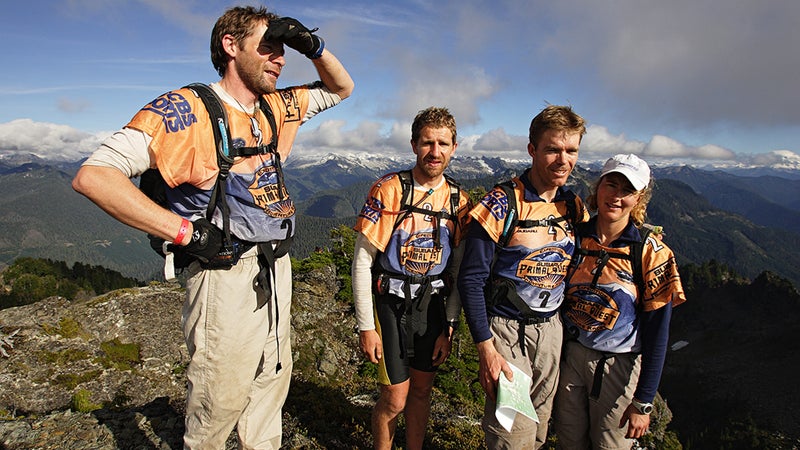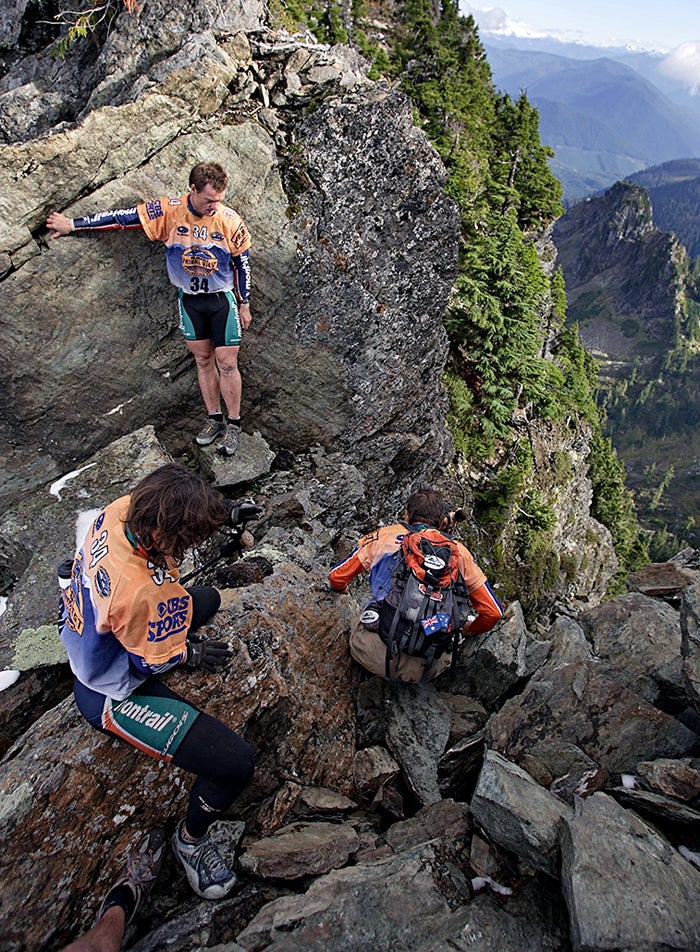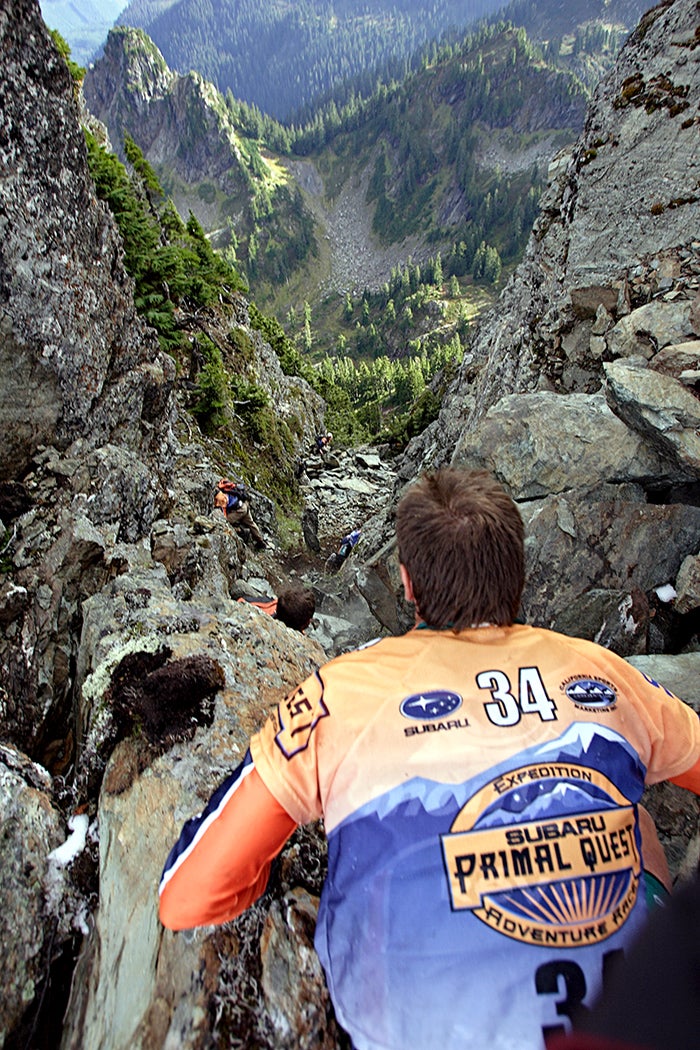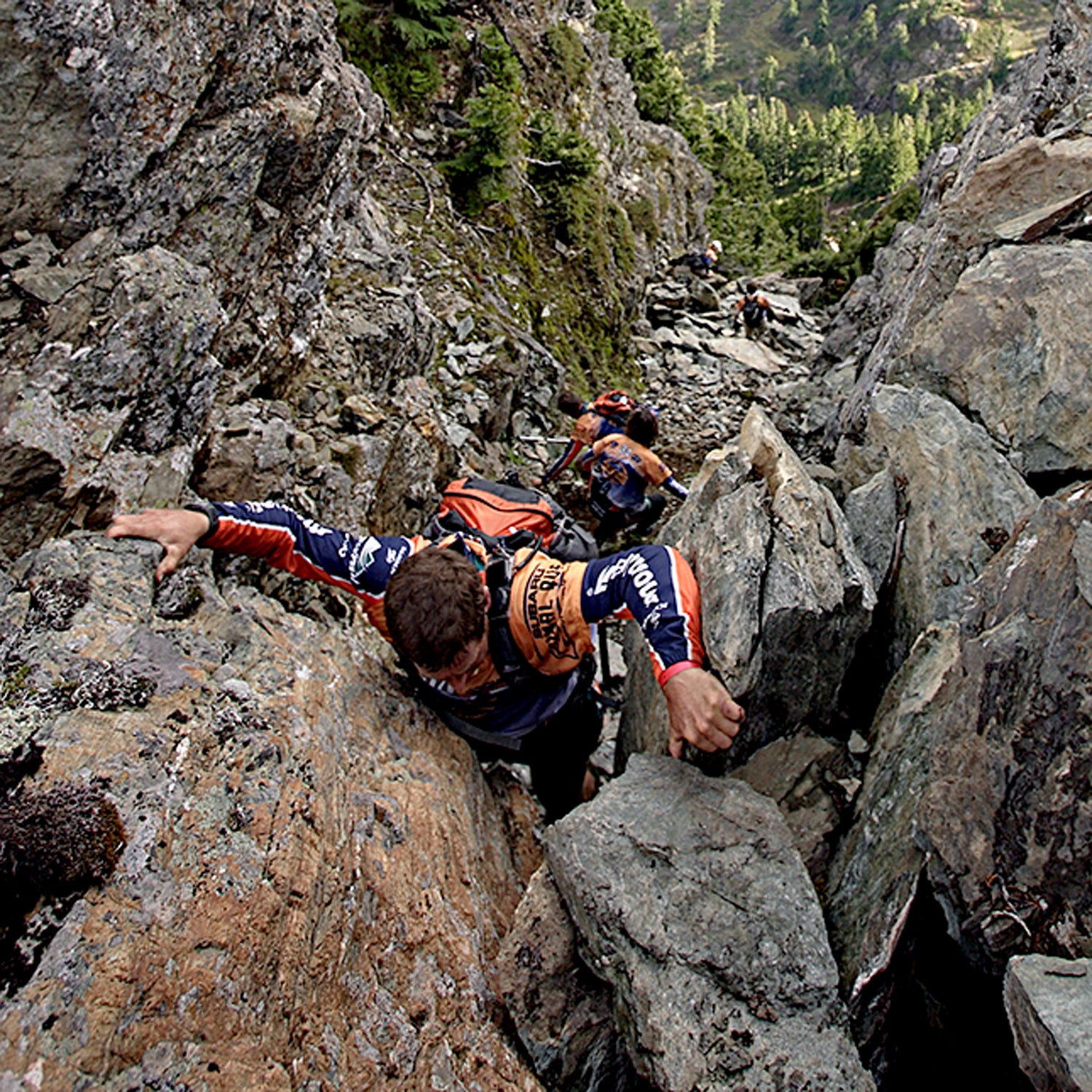In hopes of closing out 2004 with a podium finish and some sort of redemption, I set my sights on , a 400-mile expedition race in Washington’s San Juan Islands to be held that September. It seemed like the perfect place for to stage our comeback. For one, it awarded a massive prize: $100,000, the largest prize purse in the history of the sport. After our string of unsuccessful races, we all desperately needed a paycheck.
The race director boasted about the demands of the course: extraordinarily difficult navigation, intense mountain trekking, and sustained paddling sections. The extent of the technical terrain was rumored to be unprecedented. Physical prowess alone wouldn’t get you to the finish line first—or at all, for that matter. There were many a sculpted Adonis preening and strutting around the start line. Their egos would be deflated by the scrappy men and women who would inevitably pass them in the woods somewhere on the way to the finish.
On Day 1, all 56 teams pushed off from on Orcas Island, one of the many misty, quiet coves that embody the beauty of the Pacific Northwest waterways. Some teams surged ahead on the 51-mile kayak in the frigid Salish Sea, which creates the roiling dividing line between Washington and British Columbia. Others seemingly dropped anchor and drifted back until there were boats strung out for miles along the inlet, like scattered leaves. Already the leaders had a considerable time advantage on those trailing behind.
More than 10 hours later, we pulled our boats onto the mainland with four other teams. We faced an 8-mile trek followed by a long, arduous cycling section, and the temperatures were falling as the sun dipped into the Pacific. We decided to roll the dice and push through this first night with no sleep—as did many of the top teams—to force an early selection in the front of the field and separate ourselves from the pack. We breezed through our transition area, changed gear, and pushed on. Around midnight, we got on our bikes and rode into the night. So far, so good.
What lay ahead was a brutal 75-mile mountain-biking leg through Mount Baker–Snoqualmie National Forest. This section would be the undoing of more than a few teams. The forest was unforgiving, forcing teams to bushwhack at times. Many of the riders who tried to pedal through the dense vegetation ended up with dangling derailleurs and broken chains. Some teams were moving less than a mile an hour through the night—it was that bad. Our team got to be adept at shouldering and hiking with our bikes. There were long sections where I wondered why this was a mountain-biking leg at all, and I considered removing my pedals so they wouldn’t keep bashing me in the shins while I was walking.
We spent much of that section yo-yoing with Team AROC, a good-natured Aussie squad that had been leading the event from the gun. There were tricky navigation points where we’d split off, but we somehow always came back together again.

In racing there are teams you enjoy as competitive friends while others are strictly adversaries. Team AROC was definitely the former—a group of happy, hilarious, well-adjusted athletes who clearly loved the sport and the outdoors, and they let their abilities do the talking. By midafternoon [on day 3], our two teams were racing comfortably at the front with the third-place team hours behind. With two of the best navigators in the race on our two teams, we could join forces to safely and quickly get through the most onerous and technical terrain before nightfall and put a big gap between ourselves and the other teams, which would be slowed by darkness. All eight of us were in 100 percent agreement.
Race strategy aside, my team was also having a blast traveling with Team AROC, belting out Australian drinking songs, sharing stories, and breaking up the mental monotony while our bodies suffered through the course. As the lone American in the group, I was basking in the laid-back attitude, colorful commentary, and camaraderie of my now seven-person Aussie posse. As our navigators, Novak and Matt (an AROC racer with similarly razor-sharp map and compass skills) walked out front with their heads together and noses in the maps; the rest of us trotted behind and socialized like schoolkids.
We homed in on fun topics like finding a girlfriend for Nigel, which AROC always joked was one of their team’s global missions. Nigel was 38, goofy, and elfish. He loved nothing more than an adventure of any kind. We agreed that the lucky lady would have to love the outdoors, though maybe not be a racer herself, and would definitely have to be okay with a guy who doesn’t own a car, travels the world for months at a time, and doesn’t shower all that often. Somebody suggested she should be a big German woman who makes pancakes and gives massages. Fräulein Nigel! That brought a huge laugh from Nigel, which led me to believe we might be close to the truth.
The conversation continued to drift among us like the bright green grasses waving in the surrounding alpine meadows. Tom, a boyish, sandy-haired guy who seemed to never take anything very seriously, was telling me how he might quit racing soon and start a family with Alina, his wife and teammate, who was hiking along in front of us. I tried to picture this big kid having a kid of his own. I glanced around. There were wildflowers as far as the eye could see, and a clear blue stream carved through the meadow under the warmth of a late summer sun. At that moment it felt so much more like an afternoon hike in the mountains with friends than an elite, high-stakes race where $100,000 was on the line. It was one of the happiest, most enjoyable days I have had in all my years of adventure racing. Of course we couldn’t just ramble on, swapping stories and popping chocolate-covered peanuts and bison jerky into our mouths all day. As we reached the end of the meadow, I glanced up at the mossy, jagged, rocky peaks ahead and realized it would soon be time to get back to serious business.
We grew quiet as we ascended out of a peaceful green valley and into the thick woods. The fertile ground gave way to fields of loose, often deep scree. The collection of high points known as Illabot Peaks loomed in front of us, with an unmanned checkpoint atop the nearly 6,000-foot summit of the highest peak. We would have to climb the peak, mark our navigation passport, and then find a route down the other side leading to the next checkpoint.
We had a full view of the peak, which appeared to be very loose shale with slick lichen and grass growing between the cracks in the rock. As an experienced climber, I didn’t like the look of any of the routes. It was all just one giant pile of unstable, crumbling rock. We stopped to discuss our options.
None of us could see an obvious way to the summit. There was no marked trail or even a path of least resistance. The only reasonable approach we saw was to traverse a slippery, wet slope below the steepest part of the face, head left to the lower angled shoulder, and then scramble up the remaining few hundred feet on the southwest shoulder. This was by no means the most direct route, but it appeared to be the one with the mellowest angle, and we could see the entire route from where we stood, so we knew we wouldn’t encounter any unexpected cliffs. Both teams nodded in agreement and began making our way to the top.
As expected, the traverse was slick, but the slope was at a fairly low angle and the rocks were embedded, not loose. So while this section of the climb required focus, it didn’t make the hair on my neck stand up or my hands sweat. The next section was another story.
The final push to the summit was steep and technical and would demand a high level of rock climbing ability. I was personally very thankful for my years of climbing experience and doubly thankful that we hit this section of the race in broad daylight. I questioned what the middle- and back-of-the-pack teams were going to do, especially with rain looming in the forecast.
Slowly and surely we pushed upward. Every single person in that eight-racer “Aussie Army” had climbed, paddled, cycled, and hiked around the world, covering thousands of miles as adventurers. Each of us had encountered tough situations along the way. This ranked near epic for each of us. Novak, whom I regard as perhaps the toughest and by far the most stoic and silent, groused aloud, “Where the fuck are the fixed ropes? And why weren’t we told to bring helmets?” Nobody spoke another word. All eight of us were now fixated on each handhold and foot placement.
One by one, we scrambled toward the tiny, pointed summit, each of us breathing a small sigh of relief at reaching the ominous wooden cross that marked the checkpoint at the pinnacle. We marked our passports and quickly saw that although we were at the top of the mountain, we were far from being out of the woods. Anxiously perching on the knife-edge of the summit, we evaluated our options for the descent. The next checkpoint was in a valley below to the north. Based on the tight squiggly lines on the topo maps and what we could see from our vantage point, most of the routes looked dangerously steep or were obscured from view. We had no way of knowing if we’d end up cliffed out.

We narrowed our choices to two feasible options. We could reverse our steps, heading away from the next checkpoint, and climb down the loose, exposed ridge that we had just climbed up. Or we could carefully pick our way down a narrow rock gully that was a direct route and visible from where we stood on the summit. Neither of the two options was optimal, and none of us were comfortable with the situation. The mood was tense. How do you make a good decision when all of the choices seem bad? Still, we had to get out of there. We agreed that the steep, narrow gully would be faster and more efficient than backtracking, and being able to see the entire route down was a plus.
Nigel offered to take the lead and play scout. He nimbly darted into the narrow, steep gully to check it out. We waited anxiously as he surveyed the terrain. After a few minutes he gave us the thumbs-up, calling for us to follow. I felt somewhat relieved upon hearing his rich Aussie accent cutting through the cool alpine air. “It’s good!”
Despite his assurances, we knew we had to be extremely conscientious. There were loose, jagged boulders everywhere. We tentatively began to drop into the gulley one by one, first Nigel’s team and then my own. The whole peak was a pile of rubble, and I warned everyone within earshot to be careful of loose rock and extremely deliberate about where they placed their hands and feet.
My teammate John [Jacoby] followed directly in my footsteps. As he began his descent, he grabbed hold of a large boulder at the lip of the gully. Then, the unthinkable happened: John dislodged the razor-sharp microwave-sized boulder that six of us had already climbed over and pulled on. He attempted to stop the missile with his leg, and it sliced through his calf muscle like a knife through butter as it tumbled down the gully.
“Rock!” The word fell out of my mouth as instinctively as my breath. My brain had not yet registered what was happening. In an instant, my concentrated climbing focus gave way to utter confusion. I dove close to the rock wall, covered my head with my arms, and waited for the deafening, thunderous noise to stop. The rock hurled by me so closely that I could hear and feel the wind it created. It bounced against the opposite side of the canyon right next to Alina and continued on its trajectory with increasing speed. More than 100 feet below, Nigel was approaching the area where the narrow gulley started to open up into a giant rocky fan. The rock struck the back of his skull, propelling him forward as it crashed down the mountainside.
I remember a deadly silence, and then the screaming. The next minutes were spent in shock as the seven of us, still in the danger zone, took stock of each other and our surroundings and gingerly reversed our steps back toward the summit.

As we regrouped, I gravitated toward Novak, who remained strong and calm in the face of this nightmare. He looked me straight in the eye and told me how close I had come to being hit. I could see the anguish and the severity of the situation written plainly on his face, even as Alina and Tom embraced each other and yelled down to Nigel, “Hold on, we’ll get you out of here.” Alina started moaning, “He’s not moving. Why is he not moving?” Guy broke out the race radio and took charge of communicating the accident and our location to race headquarters.
The only other souls for miles around were Rob Raker, a professional rock climbing guide, and race photographer Dan Campbell, who had climbed to the summit to take pictures of the teams as they reached the peak. Rob offered to make the technical climb down to Nigel to check on his condition, an offer we immediately and gratefully accepted. Meanwhile, Novak and I raided our first aid kit to begin treating John, whose sliced Achilles and bone-deep calf laceration were filling his shoe with blood. We could see straight to his tendon and bones. There was no way he was going to get out of there on his own power. We needed emergency evacuation.
Minutes later, Rob radioed up and confirmed our darkest fear. Nigel was dead. Killed instantly from massive head trauma. As I sat there, stunned by the reality that was at once shaking me to my core and yet still stubbornly refusing to seep in, I was silently thanking Rob for taking the responsibility to check on Nigel. I was grateful that none of us, his friends, would have the horrific image of his mangled body burned into our minds, forever clouding our recollection of him.
Nightfall was approaching, and John’s injuries were too severe for him to move. Our safety on the peak was tentative at best. If the rescue helicopter could not land, we were in for a horrible night, during which we stood a good chance of losing John too.
Novak, Rob, and I opted to stay with John on the peak and do our best to stabilize him while Alina, Tom, and Matt from Team AROC joined Guy and made the slow, cautious 500-foot descent to an organized helicopter-landing zone in the meadow, where the race officials would meet them. We were still perched on the treacherously loose rock at the head of the gully. The only place the helicopter would be able to evacuate us was from the very top of the peak, 15 feet above us. Those 15 feet were slippery, loose climbing with devastating exposure. Novak and I managed to assist John as he crawled to the summit. We laid him down on packs and insulated him with our space blankets and sparse extra clothing. We elevated his leg and kept pressure on the wound while listening to the helicopter pilot attempt, time and time again, to put a skid down long enough to pick us up.
It had been hours since the accident. Our window of opportunity continued to close as the helicopter repeatedly tried to execute this difficult maneuver. The adrenaline had long since worn off, and the cold reality was setting in. John was turning white, shivering, and losing way too much blood. He had soaked through all of our medical supplies. Finally, just minutes before dark, the pilot hovered long enough above the peak for us to lift John into the chopper. I dove in with him and, with no space left in the helicopter, left Novak and Rob on the peak to walk out in the dark. The helicopter took us directly to a medical facility, where John received 30 stitches in his leg. Soon afterward, we were driven back to the race camp and reunited with the rest of both teams and our crew members.
The gravity of the day’s events set in while we huddled together in sadness, shock, and despair. We were required to meet with a race psychologist for an official debriefing on what we were to do in the hours that followed in order to stave off depression. I sat dumbfounded as he instructed us to hydrate, avoid alcohol, and do some light exercise. Who the fuck was this guy, and did he really not have any idea what we had been doing prior to the accident? In the true Aussie tradition, we piled into the car and drove one block to the nearest pub.
The next few days were as surreal as the accident. In the wake of Nigel’s death, the race had come to a screeching halt. It had taken another full day until rescue teams could safely recover his body. The organizers held a memorial service by the river we were meant to be paddling on. Teams had been pulled from their various positions on the course and gathered at this transition area to remember Nigel. After the service, when emotions were still sparking like exposed wires, the organization started the serious and contentious discussions about how to handle the remainder of the race.
They took input from each team captain and deliberated for hours. Racers were sharply divided on whether or not to continue. A few fellow racers whom I had known for years and considered friends shocked me with their lack of sympathy and overly competitive nature. I was disgusted that some individuals were still chomping at the bit to race for a piece of the prize purse—a prize purse that most likely would have been awarded to Nigel and Team AROC had it not been for the accident. American Danelle Ballengee, one of the best athletes in the world, suggested that we all continue the course together in a noncompetitive tribute to Nigel and donate the prize money to his family. That sounded like the most fitting way to honor Nigel and bond together as a race community. The majority voted otherwise. After hours of group deliberations, the race officials elected to continue the event, minus the mountain section where the accident occurred and minus the two teams who’d been leading. The race surged ahead full steam, with a black cloud hanging over many of the staff and participants.
Instead of coming together as a community in the face of tragedy, we were pulled apart. In the wake of the accident, people sadly but predictably started pointing fingers and looking for someone to blame. Some racers blamed the race organizer, saying the course was too dangerous and that we never should have been forced onto that peak. Others blamed us, criticizing our teams’ decision to descend via that route. I felt like an outcast in my own community and abandoned by my peers. Of the seven survivors from the accident, a few got vocal about safety in adventure racing, one got really silent, and the rest of us were somewhere in between, defending ourselves, cringing at the chatter in the media, and wanting it all to just go away.
In all of my experience racing in very extreme, remote situations, this was only the second death to take place during an event. The statistics are remarkable when you consider the terrain we travel, the conditions, and the circumstances. I thought back to the Raid [Gauloises] in Kyrgyzstan when Dominique Roberts of the French Team Endurance-ACG drowned in a white-water river section. In contrast to Nigel’s death, Dominique’s was a true accident, despite there being safety measures in place. The river section in Kyrgyzstan was challenging. However all of the teams were geared up with helmets, life jackets, throw bags and other required safety equipment appropriate for that section. There were also river safety crews along the shore to assist in any necessary rescue. They were on scene when Dominique’s kayak overturned. Despite their efforts, they were not able to save her. The athletes obviously mourned for their friend and fellow racer, but there was no finger pointing or blame being thrown around. We understood these risks when we lined up to race. We were all truly sad and shaken by the accident, and it drew us together.
Conversely, Nigel’s death had a polarizing effect. Many athletes, including me, felt that the peak was a bad place for a checkpoint and that the accident was preventable. Yes, adventure racing is dangerous, we didn’t expect a race director to keep us entirely safe, and being able to make navigational decisions is one of the appeals of adventure racing. However, placing a checkpoint on Illabot Peaks, with exposed loose rock and no clear option for descent, amounted to poor course design and unnecessary risk. The navigational challenge would have been the same if the checkpoint had been located in the saddle below the peak.
I also had a hard time accepting the critique of our route choice from other racers who never saw that part of the course. No one else had the firsthand information necessary to evaluate the severity of the terrain. Nigel’s death forced me to ask some bigger questions too. Had adventure racing finally been pushed too far? Was the extreme amount of prize money changing the way we raced and treated each other? All I know is that I was seeing an unexpected ugly side of the sport and I wanted no part of it.
Time does funny things to your memory. On that day, I saw absolutely no better choice for a safe descent off that peak. Yet the more days and weeks that passed, the more vicious my thought processes became. I second-guessed everything about that day. Should I have been more vocal about the climbing dangers? It wasn’t safe. But how do you define “safe” in the backcountry anyway? Would I do something differently the next time? After all these years, I still don’t know the answers to these questions.
What I do know is that no one ever expects an accident to happen. Time and time again, we skate through exhilarating moments in the outdoors that cause us to look back and feel lucky to have squeaked through. These moments add color and character to our stories and our lives. Yet the same situations that make us feel alive can turn deadly in an instant. You never fully appreciate that . . . until they do.
Excerpt adapted for ���ϳԹ��� from by Rebecca Rusch, with permission of VeloPress.


